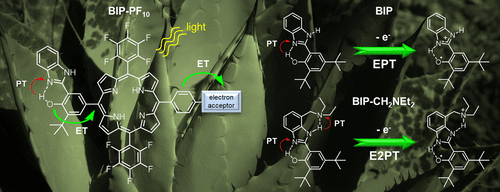当前位置:
X-MOL 学术
›
Acc. Chem. Res.
›
论文详情
Our official English website, www.x-mol.net, welcomes your
feedback! (Note: you will need to create a separate account there.)
Proton-Coupled Electron Transfer in Artificial Photosynthetic Systems
Accounts of Chemical Research ( IF 16.4 ) Pub Date : 2018-01-08 00:00:00 , DOI: 10.1021/acs.accounts.7b00491 S. Jimena Mora 1 , Emmanuel Odella 1 , Gary F. Moore 1 , Devens Gust 1 , Thomas A. Moore 1 , Ana L. Moore 1
Accounts of Chemical Research ( IF 16.4 ) Pub Date : 2018-01-08 00:00:00 , DOI: 10.1021/acs.accounts.7b00491 S. Jimena Mora 1 , Emmanuel Odella 1 , Gary F. Moore 1 , Devens Gust 1 , Thomas A. Moore 1 , Ana L. Moore 1
Affiliation

|
Artificial photosynthetic constructs can in principle operate more efficiently than natural photosynthesis because they can be rationally designed to optimize solar energy conversion for meeting human demands rather than the multiple needs of an organism competing for growth and reproduction in a complex ecosystem. The artificial photosynthetic constructs described in this Account consist primarily of covalently linked synthetic chromophores, electron donors and acceptors, and proton donors and acceptors that carry out the light absorption, electron transfer, and proton-coupled electron transfer (PCET) processes characteristic of photosynthetic cells.
中文翻译:

人工光合系统中质子耦合电子的转移
原则上,人工光合作用的构造可以比自然光合作用更有效地运行,因为可以合理地设计它们以优化太阳能转化以满足人类的需求,而不是生物体在复杂的生态系统中竞争生长和繁殖的多重需求。该帐户中描述的人工光合作用构建体主要由共价连接的合成生色团,电子供体和受体以及质子供体和受体组成,它们执行光合细胞特征性的光吸收,电子转移和质子耦合电子转移(PCET)过程。
更新日期:2018-01-08
中文翻译:

人工光合系统中质子耦合电子的转移
原则上,人工光合作用的构造可以比自然光合作用更有效地运行,因为可以合理地设计它们以优化太阳能转化以满足人类的需求,而不是生物体在复杂的生态系统中竞争生长和繁殖的多重需求。该帐户中描述的人工光合作用构建体主要由共价连接的合成生色团,电子供体和受体以及质子供体和受体组成,它们执行光合细胞特征性的光吸收,电子转移和质子耦合电子转移(PCET)过程。











































 京公网安备 11010802027423号
京公网安备 11010802027423号